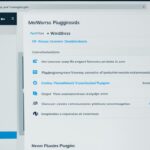Table of Contents
Welcome to our quick guide on how to clear cache on your WordPress site. Clearing cache is a crucial step in optimizing your website’s performance and ensuring a smooth user experience. By clearing cache, you can speed up your WordPress site, improve its loading time, and make sure that your visitors are always seeing the latest content.
In this guide, we will walk you through the process of clearing cache on various levels for your WordPress site. From browser cache to plugin cache, theme cache, and server-side cache, we will cover it all. Whether you’re a beginner or an experienced WordPress user, this guide will provide you with all the necessary steps in a clear and concise manner.
Key Takeaways:
- Clearing cache is essential for optimizing website performance and improving user experience.
- WordPress has multiple types of cache, including browser cache, plugin cache, theme cache, and server-side cache.
- Clearing cache ensures that visitors see the latest content on your website.
- By following the step-by-step instructions in this guide, you can efficiently clear cache on your WordPress site.
- Remember to clear cache regularly to maintain optimal performance.
Understanding Cache in WordPress
Before we dive into the process of clearing cache, it’s essential to have a solid understanding of what cache is and how it works in WordPress. Cache refers to the temporary storage of website data that allows for faster retrieval and delivery to users.
In WordPress, cache plays a crucial role in optimizing website performance by storing static versions of web pages, images, and other elements. When a visitor requests a page, WordPress checks if it has a cached version. If it does, the cached version is served, resulting in faster loading times and reduced server load.
The primary purpose of cache is to improve website speed and efficiency. It helps prevent unnecessary processing of dynamic content and reduces the server’s workload, leading to a smoother user experience.
Why is Cache Important for WordPress Websites?
Cache is essential for WordPress websites for several reasons:
- Improved Loading Speed: Cached files load faster, reducing waiting times for visitors and improving user experience.
- Better Scalability: Caching allows websites to handle increased traffic without overwhelming the server, enabling smoother performance during peak periods.
- Reduced Server Load: By serving cached content instead of generating it dynamically, the server’s resources are freed up for other tasks, resulting in improved efficiency.
- Enhanced SEO: Site speed is a crucial factor in search engine rankings. A faster website due to caching can positively impact SEO and organic traffic.
Having a clear understanding of cache and its benefits sets the foundation for efficiently managing and troubleshooting cache-related issues on WordPress websites. Now that we’ve explored the importance of cache, let’s move on to the different types of cache in WordPress and how they affect website performance.
Types of Cache in WordPress
| Cache Type | Description |
|---|---|
| Browser Cache | Cache stored on visitors’ web browsers to reduce server requests and improve page load times. |
| Page Cache | Cache generated by WordPress plugins or caching solutions to store fully rendered HTML versions of web pages for quick retrieval. |
| Object Cache | Cache used to store frequently accessed and computationally expensive data, such as database queries, to speed up retrieval. |
| Server-Side Cache | Cache implemented on the server to store static versions of web pages and assets for faster delivery. |
Understanding the different types of cache in WordPress is crucial for effectively managing cache and optimizing website performance. In the next sections, we will explore how to clear cache for each cache type to ensure your website reflects the latest changes and offers an exceptional user experience.
Types of Cache in WordPress
In WordPress, different types of cache play a significant role in optimizing website performance. Understanding these variations is essential when it comes to clearing cache effectively. Let’s take a closer look at the three main types of cache in WordPress:
1. Browser Cache
Browser cache is a type of cache that is stored on the user’s web browser. It saves static files, such as JavaScript, CSS, and images, locally on the user’s device.
This cache type allows the browser to load web pages faster by retrieving files from the local cache, rather than requesting them from the server every time. However, it can also lead to outdated content being displayed if the cache is not cleared.
Clearing browser cache ensures that users see the latest version of your website, including any recent updates or changes. To clear browser cache, follow the steps specific to the web browser you are using. Here is a quick guide for the most popular web browsers:
- Google Chrome
- Mozilla Firefox
- Safari
2. Object Cache
Object cache is a cache mechanism that stores database queries and results, as well as other temporary data, in the server’s memory. It helps speed up the retrieval of frequently accessed data and reduces the server load.
Clearing the object cache ensures that the latest database queries are executed and the most up-to-date data is retrieved for your website.
3. Page Cache
Page cache, also known as full-page cache, stores the entire HTML output of a webpage as a static file. This allows subsequent requests for the same page to be served quickly without the need to generate the content dynamically from the server.
Clearing the page cache ensures that any changes made to your website’s content or layout are immediately reflected in the cached version.
Understanding these different types of cache in WordPress enables you to make informed decisions about which caches to clear based on the changes you have made to your site. Now that we have explored the types of cache in WordPress, let’s move on to the step-by-step processes of clearing cache specific to each type.
Clearing Browser Cache
Browser cache is an essential component that stores website data locally, resulting in faster loading times and improved user experience. However, it is essential to clear the browser cache periodically to ensure you’re viewing the most recent version of a webpage.
In this section, we will guide you through the process of clearing the browser cache in popular web browsers, including Chrome, Firefox, and Safari. By following these simple steps, you can clear the cache and enjoy a seamless browsing experience.
Clearing Browser Cache in Google Chrome
- Open Google Chrome and click on the three-dot menu icon in the top-right corner of the browser window.
- From the dropdown menu, hover over the “More tools” option and then click on “Clear browsing data.”
- In the pop-up window, select the time range for which you want to clear the cache. If you want to clear the entire cache, choose “All time.”
- Make sure the “Cached images and files” option is checked.
- Click on the “Clear data” button to clear the browser cache.
Clearing Browser Cache in Mozilla Firefox
- Launch Mozilla Firefox and click on the three-line menu icon in the top-right corner of the browser window.
- Select “Options” from the dropdown menu.
- In the left sidebar, click on “Privacy & Security.”
- Scroll down to the “Cookies and Site Data” section and click on the “Clear Data” button.
- Ensure that the checkbox next to “Cached Web Content” is selected.
- Click on the “Clear” button to clear the browser cache.
Clearing Browser Cache in Apple Safari
- Open Apple Safari and click on the “Safari” option in the top menu bar.
- From the dropdown menu, click on “Preferences.”
- In the Preferences window, select the “Privacy” tab.
- Click on the “Manage Website Data” button.
- In the subsequent popup, click on “Remove All” to clear the browser cache.
- Click on “Done” to save the changes.
Remember to periodically clear the browser cache to ensure you’re experiencing websites in their most up-to-date form. This practice can help prevent loading issues, display glitches, and other performance-related problems.
Now that you’ve learned how to clear the browser cache in popular web browsers, let’s move on to the next section, where we will discuss clearing the cache generated by plugins on your WordPress site.

Clearing Plugin Cache
WordPress plugins often utilize their own cache to optimize website performance. When plugins generate cache, it can sometimes prevent the latest content from being displayed. In this section, we will guide you through the process of clearing the plugin cache to ensure that your website visitors see the most up-to-date information.
To clear the plugin cache, follow these simple steps:
- Step 1: Log in to your WordPress dashboard.
- Step 2: Navigate to the “Plugins” section.
- Step 3: Identify the plugin that is generating the cache that you want to clear.
- Step 4: Disable the plugin temporarily.
- Step 5: Clear the cache created by the plugin using the plugin’s settings or options.
- Step 6: Once the cache is cleared, re-enable the plugin.
- Step 7: Visit your website to ensure that the latest content is now being displayed.
Clearing the plugin cache is an important step to ensure that your website is always showing the most recent updates. By following these steps, you can effectively clear the cache generated by your installed plugins and provide your visitors with the best user experience.
If you still encounter any issues with the plugin cache, you may need to consult the plugin’s documentation or support team for further assistance.
Example:
“Clearing the plugin cache was a game-changer for my website. Not only did it significantly improve the loading speed, but it also ensured that my visitors were seeing the latest content. The step-by-step guide provided in this section was incredibly helpful and made the process so much easier.”
Benefits of Clearing Plugin Cache:
| Benefits | Description |
|---|---|
| Improved Performance | Clearing the plugin cache can speed up your website by removing outdated and unnecessary data. |
| Updated Content | By clearing the cache, you ensure that the latest content is displayed to your website visitors. |
| Optimal User Experience | A faster website with up-to-date content provides a better user experience, resulting in higher engagement and satisfaction. |
Clearing WordPress Theme Cache
When making changes to your WordPress theme files, such as customizing the design or adding functionality, it’s important to clear the theme cache so that the updated version of your theme is displayed to your website visitors. Failure to clear the theme cache can result in the old version of your theme being cached and shown on your site.
Clearing the WordPress theme cache is a straightforward process. Follow these steps to ensure that your website reflects the most recent changes made to your theme:
- Access your WordPress dashboard and navigate to Appearance > Themes.
- Select the theme that you have made changes to. If you’re using a child theme, make sure to select the child theme and not the parent theme.
- Once you’ve selected the theme, click on the Theme Details button.
- In the theme details screen, you’ll find a Theme Cache section. Under this section, you’ll see an option to clear the theme cache.
- Click on the Clear Cache button to remove the cached version of your theme.
After clearing the theme cache, your website will display the updated version of your theme, reflecting any recent changes you’ve made.
Keep in mind that the steps mentioned here may vary slightly depending on the WordPress theme you’re using. Some themes might have specific options or settings related to clearing the theme cache. Consult your theme’s documentation for detailed instructions if you’re unsure.
Benefits of Clearing the WordPress Theme Cache
Clearing the theme cache can provide several benefits for your website:
- Real-time updates: By clearing the theme cache, you ensure that any modifications or enhancements you’ve made to your theme files are immediately visible to your site visitors.
- Improved performance: Updated theme files can optimize your website’s performance and speed, resulting in a better user experience.
- Bug fixes: Clearing the theme cache can help resolve any lingering issues or bugs that might have been present in the previous cached version of your theme.
By regularly clearing the WordPress theme cache, you can ensure that your website stays up to date, performs at its best, and provides an engaging and smooth user experience.
Clearing Server-Side Cache
If your WordPress site is hosted on a server that utilizes server-side caching, you will need to know how to clear this cache to see immediate changes. Server-side caching can greatly enhance your website’s performance and load speeds, but it can also sometimes hinder the visibility of recent updates and modifications.
To clear the server-side cache, follow these step-by-step instructions:
- Contact your web hosting provider: Reach out to your hosting provider’s support team and inquire about the process for clearing the server-side cache. They will be able to guide you with specific instructions based on your hosting environment.
- Access your hosting control panel: Log in to your hosting control panel, such as cPanel or Plesk, using the provided credentials.
- Navigate to cache settings: Locate the cache settings or management section within your hosting control panel. It may be labeled differently depending on your host, but it should be easily identifiable.
- If using cPanel: Look for options like “Cache Manager” or “Cache Settings”.
- If using Plesk: Look for options like “Website & Domains” or “Web Hosting Settings”.
Clearing the server-side cache ensures that any updates or modifications you make to your WordPress site are immediately reflected and visible to your visitors. By following these instructions, you can effectively clear the server-side cache and enhance the overall user experience on your website.
Conclusion
In conclusion, clearing cache on your WordPress site is essential to ensure optimal performance and speed. By following the steps outlined in this guide, you can efficiently clear cache and improve the overall user experience. Remember to clear different types of cache, including browser cache, plugin cache, theme cache, and server-side cache, to achieve the best results.
Clearing browser cache helps in storing website data locally, clearing plugin cache ensures the latest content is displayed, and clearing theme cache reflects any recent changes made to the theme files. Additionally, clearing server-side cache is crucial if your WordPress site is hosted on a server that utilizes server-side caching.
Regularly clearing cache is a proactive measure to prevent website slowdowns, enhance website speed, and provide visitors with a seamless browsing experience. Implementing these cache-clearing practices will make a noticeable difference in how your WordPress site performs and ultimately contribute to its success.
FAQ
How does cache impact website speed?
Cache plays a significant role in improving website speed. It stores pre-generated data or elements of a webpage, allowing it to load faster when a user visits the site. By reducing the time it takes to retrieve and render web pages, cache optimization enhances the overall user experience.
What is browser cache?
Browser cache refers to the storage of website files, such as HTML, CSS, and images, locally on a user’s device. When a user revisits a webpage, their browser can quickly retrieve these files from the cache instead of downloading them again from the server. Clearing browser cache ensures that users see the most up-to-date content on your site.
How do I clear browser cache in Chrome?
To clear browser cache in Google Chrome, follow these steps:
1. Click on the three-dot menu in the top-right corner of the browser.
2. Go to “More Tools” and then “Clear browsing data.”
3. Select “Cached images and files” and any other data you want to remove.
4. Click on the “Clear data” button to clear your browser cache.
How do I clear plugin cache in WordPress?
To clear plugin cache in WordPress, follow these steps:
1. In your WordPress Dashboard, go to the “Plugins” menu.
2. Find the plugin that is generating cache for your site.
3. Deactivate the plugin temporarily.
4. Reactivate the plugin to clear its cache.
5. Verify that the cache has been cleared by checking your site’s frontend.
Why should I clear WordPress theme cache?
Clearing WordPress theme cache is necessary when you make changes to your theme files or customize the appearance of your site. By clearing the theme cache, you ensure that the updated version of your theme is displayed to visitors, reflecting the recent modifications you’ve made.
How can I clear server-side cache in WordPress?
Clearing server-side cache in WordPress depends on your hosting environment. If your server utilizes caching mechanisms like Varnish or Redis, you may need to consult your hosting provider or access the server’s control panel to manage and clear the cache effectively.
Is clearing cache on my WordPress site necessary?
Yes, clearing cache on your WordPress site is essential for optimal performance. Regularly clearing cache, including browser cache, plugin cache, theme cache, and server-side cache, ensures that your site loads quickly and displays the most recent version of your content, offering an enhanced user experience.












